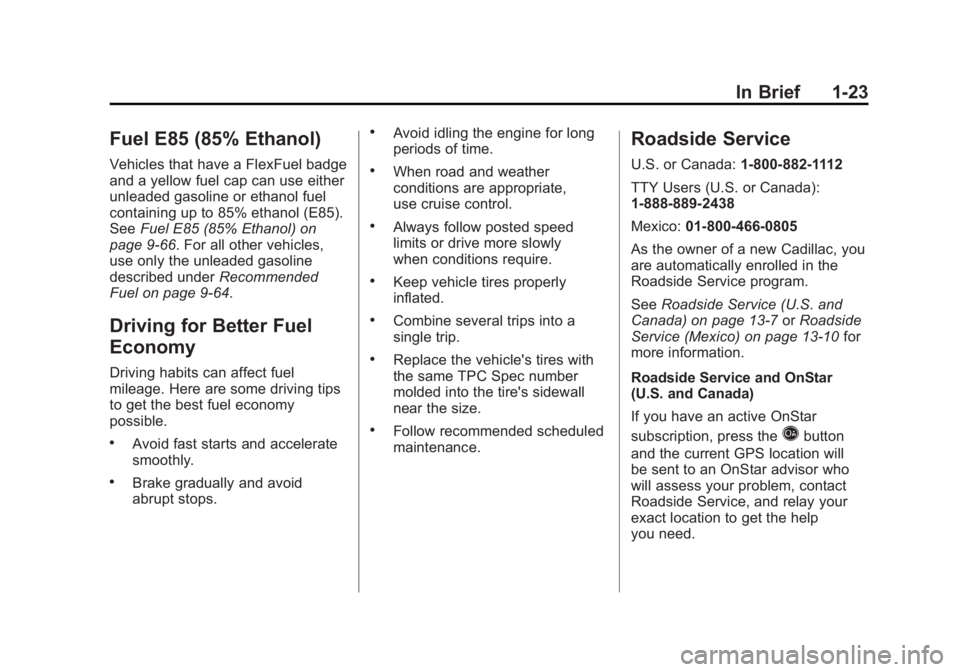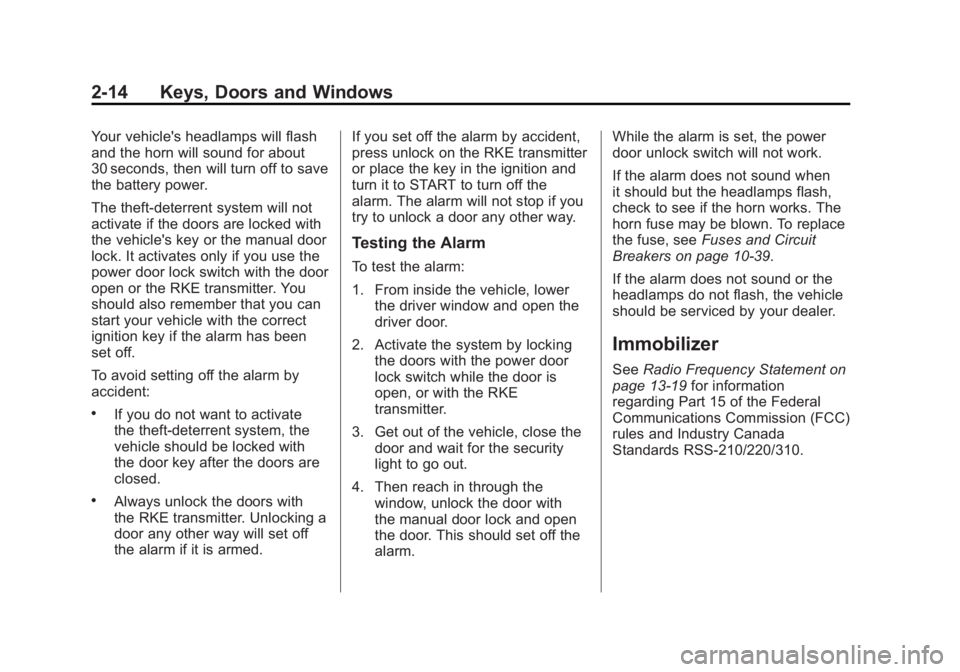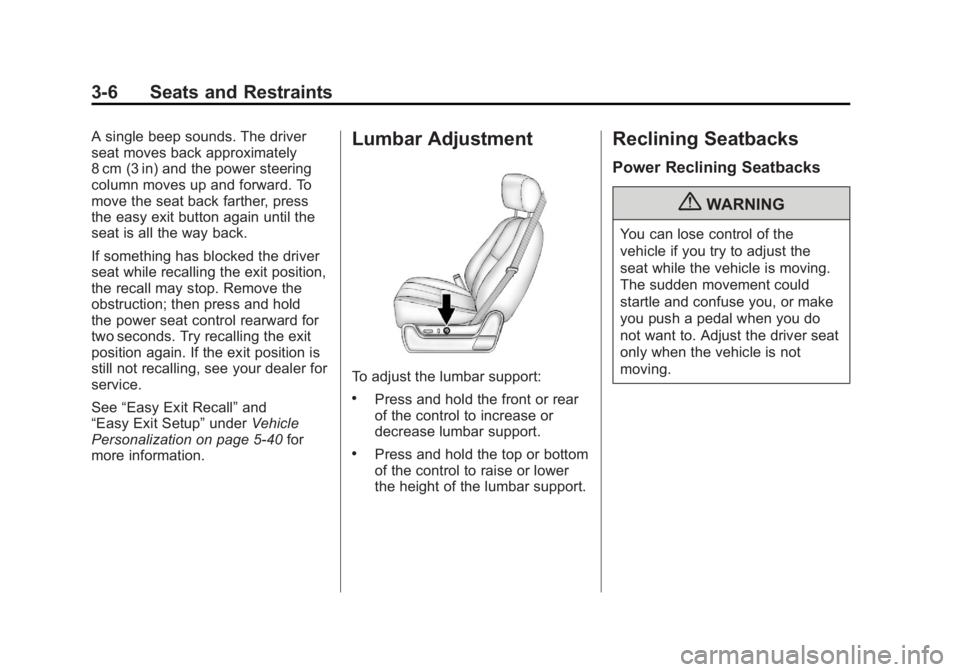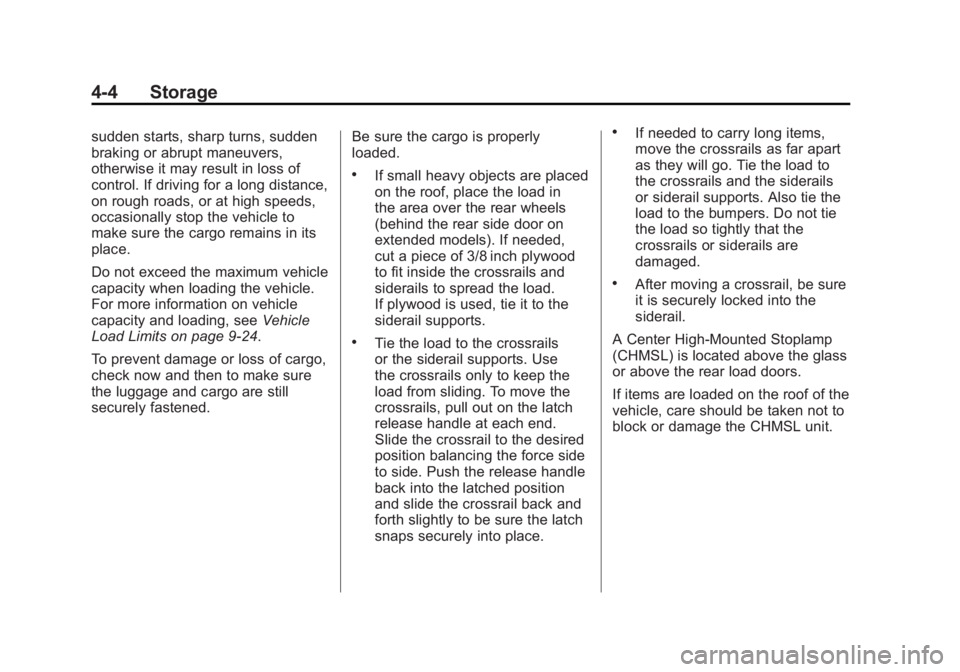stop start CADILLAC ESCALADE ESV 2011 Owners Manual
[x] Cancel search | Manufacturer: CADILLAC, Model Year: 2011, Model line: ESCALADE ESV, Model: CADILLAC ESCALADE ESV 2011Pages: 548, PDF Size: 8.45 MB
Page 28 of 548

Black plate (22,1)Cadillac Escalade/Escalade ESV Owner Manual - 2011
1-22 In Brief For more information, see
StabiliTrak ®
System on page 9 ‑ 47 .
Tire Pressure Monitor This vehicle may have a Tire
Pressure Monitor System (TPMS).
The TPMS warning light alerts you
to a significant loss in pressure of
one of the vehicle's tires. If the
warning light comes on, stop as
soon as possible and inflate the
tires to the recommended pressure shown on the Tire and Loading
Information label. See Vehicle Load
Limits on page 9 ‑ 24 . The warning
light will remain on until the tire
pressure is corrected.
During cooler conditions, the low tire
pressure warning light may appear
when the vehicle is first started and
then turn off. This may be an early
indicator that the tire pressures are
getting low and the tires need to be
inflated to the proper pressure.
The TPMS does not replace normal
monthly tire maintenance. It is the
driver ’ s responsibility to maintain
correct tire pressures.
See Tire Pressure Monitor System
on page 10 ‑ 54 . Engine Oil Life System The engine oil life system calculates
engine oil life based on vehicle use
and displays a DIC message when
it is necessary to change the engine
oil and filter. The oil life system
should be reset to 100% only
following an oil change.
Resetting the Oil Life System
1. Display OIL LIFE REMAINING
on the DIC.
2. Press and hold the SET/RESET
button on the DIC for more than
five seconds. The oil life will
change to 100%.
See Engine Oil Life System on
page 10 ‑ 10 .
Page 29 of 548

Black plate (23,1)Cadillac Escalade/Escalade ESV Owner Manual - 2011
In Brief 1-23
Fuel E85 (85% Ethanol) Vehicles that have a FlexFuel badge
and a yellow fuel cap can use either
unleaded gasoline or ethanol fuel
containing up to 85% ethanol (E85).
See Fuel E85 (85% Ethanol) on
page 9 ‑ 66 . For all other vehicles,
use only the unleaded gasoline
described under Recommended
Fuel on page 9 ‑ 64 .
Driving for Better Fuel
Economy Driving habits can affect fuel
mileage. Here are some driving tips
to get the best fuel economy
possible. .
Avoid fast starts and accelerate
smoothly. .
Brake gradually and avoid
abrupt stops. .
Avoid idling the engine for long
periods of time. .
When road and weather
conditions are appropriate,
use cruise control. .
Always follow posted speed
limits or drive more slowly
when conditions require. .
Keep vehicle tires properly
inflated. .
Combine several trips into a
single trip. .
Replace the vehicle's tires with
the same TPC Spec number
molded into the tire's sidewall
near the size. .
Follow recommended scheduled
maintenance. Roadside Service U.S. or Canada: 1-800-882-1112
TTY Users (U.S. or Canada):
1-888-889-2438
Mexico: 01-800-466-0805
As the owner of a new Cadillac, you
are automatically enrolled in the
Roadside Service program.
See Roadside Service (U.S. and
Canada) on page 13 ‑ 7 or Roadside
Service (Mexico) on page 13 ‑ 10 for
more information.
Roadside Service and OnStar
(U.S. and Canada)
If you have an active OnStar
subscription, press the
Q button
and the current GPS location will
be sent to an OnStar advisor who
will assess your problem, contact
Roadside Service, and relay your
exact location to get the help
you need.
Page 38 of 548

Black plate (6,1)Cadillac Escalade/Escalade ESV Owner Manual - 2011
2-6 Keys, Doors and Windows
/ (Remote Start): This button
will be on the RKE transmitter if
you have remote start.
To start the vehicle using the remote
start feature:
1. Aim the transmitter at the
vehicle.
2. Press and release
Q . The
vehicle's doors will lock.
Immediately press and hold
/until the turn signal lamps flash.
If you cannot see the vehicle's
lamps, press and hold
/ for
two to four seconds. Pressing
/again after the vehicle has
started will turn the engine off.
When the vehicle starts, the
parking lamps will turn on and
remain on while the engine is
running.
If the vehicle is left running it
will automatically shut off after
10 minutes unless a time
extension has been done. 3. If it is the first remote start since
the vehicle has been driven,
repeat these steps, while the
engine is still running, to extend
the engine running time by
10 minutes. Remote start can
be extended one time.
After entering the vehicle during a
remote start, insert and turn the key
to ON/RUN to drive the vehicle.
To manually shut off a remote start,
do any of the following: .
Aim the RKE transmitter at the
vehicle and
/ until the parking
lamps turn off. .
Turn on the hazard warning
flashers. .
Turn the ignition on and then
back off.
The vehicle can be remote started
two separate times between driving
sequences. The engine will run for
10 minutes after each remote start. Or, you can extend the engine run
time by another 10 minutes within
the first 10 minute remote start time
frame, and before the engine stops.
For example, if
Q and then
/ are
pressed again after the vehicle
has been running for five minutes,
10 minutes are added, allowing the
engine to run for 15 minutes.
The additional 10 minutes are
considered a second remote
vehicle start.
After the vehicle's engine has been
started two times using
/ , or a
single remote start with one time
extension, the vehicle must be
started with the key.
After the key is removed from the
ignition, the vehicle can be remote
started again.
The vehicle cannot be remote
started if the key is in the ignition,
the hood is not closed, or if there
is an emission control system
malfunction and the malfunction
indicator lamp is on.
Page 39 of 548

Black plate (7,1)Cadillac Escalade/Escalade ESV Owner Manual - 2011
Keys, Doors and Windows 2-7Also, the engine will turn off during a
remote vehicle start if the coolant
temperature gets too high or if the
oil pressure gets low.
Door Locks
{ WARNINGUnlocked doors can be
dangerous. .
Passengers, especially
children, can easily open
the doors and fall out of a
moving vehicle. When a door
is locked, the handle will not
open it. The chance of being
thrown out of the vehicle
in a crash is increased if the
doors are not locked. So, all
passengers should wear
safety belts properly and
the doors should be locked
whenever the vehicle is
driven.
(Continued) WARNING (Continued) .
Young children who get into
unlocked vehicles may be
unable to get out. A child can
be overcome by extreme heat
and can suffer permanent
injuries or even death from
heat stroke. Always lock the
vehicle whenever leaving it. .
Outsiders can easily enter
through an unlocked door
when you slow down or stop
the vehicle. Locking the doors
can help prevent this from
happening.
There are several ways to lock and
unlock the vehicle.
From outside, use the Remote
Keyless Entry (RKE) transmitter or
the key in the driver door. From inside, use the power door
locks or manual door locks. To lock
or unlock the door with the manual
locks, push down or pull up on the
manual lock knob.
Power Door Locks With power door locks, the switches
on the front doors can be used to
lock and unlock the vehicle.
K (Unlock): Press to unlock the
doors.
Q (Lock): Press to lock the doors.
Page 46 of 548

Black plate (14,1)Cadillac Escalade/Escalade ESV Owner Manual - 2011
2-14 Keys, Doors and Windows Your vehicle's headlamps will flash
and the horn will sound for about
30 seconds, then will turn off to save
the battery power.
The theft-deterrent system will not
activate if the doors are locked with
the vehicle's key or the manual door
lock. It activates only if you use the
power door lock switch with the door
open or the RKE transmitter. You
should also remember that you can
start your vehicle with the correct
ignition key if the alarm has been
set off.
To avoid setting off the alarm by
accident: .
If you do not want to activate
the theft-deterrent system, the
vehicle should be locked with
the door key after the doors are
closed. .
Always unlock the doors with
the RKE transmitter. Unlocking a
door any other way will set off
the alarm if it is armed. If you set off the alarm by accident,
press unlock on the RKE transmitter
or place the key in the ignition and
turn it to START to turn off the
alarm. The alarm will not stop if you
try to unlock a door any other way.
Testing the Alarm To test the alarm:
1. From inside the vehicle, lower
the driver window and open the
driver door.
2. Activate the system by locking
the doors with the power door
lock switch while the door is
open, or with the RKE
transmitter.
3. Get out of the vehicle, close the
door and wait for the security
light to go out.
4. Then reach in through the
window, unlock the door with
the manual door lock and open
the door. This should set off the
alarm. While the alarm is set, the power
door unlock switch will not work.
If the alarm does not sound when
it should but the headlamps flash,
check to see if the horn works. The
horn fuse may be blown. To replace
the fuse, see Fuses and Circuit
Breakers on page 10 ‑ 39 .
If the alarm does not sound or the
headlamps do not flash, the vehicle
should be serviced by your dealer.
Immobilizer See Radio Frequency Statement on
page 13 ‑ 19 for information
regarding Part 15 of the Federal
Communications Commission (FCC)
rules and Industry Canada
Standards RSS-210/220/310.
Page 62 of 548

Black plate (6,1)Cadillac Escalade/Escalade ESV Owner Manual - 2011
3-6 Seats and Restraints A single beep sounds. The driver
seat moves back approximately
8 cm (3 in) and the power steering
column moves up and forward. To
move the seat back farther, press
the easy exit button again until the
seat is all the way back.
If something has blocked the driver
seat while recalling the exit position,
the recall may stop. Remove the
obstruction; then press and hold
the power seat control rearward for
two seconds. Try recalling the exit
position again. If the exit position is
still not recalling, see your dealer for
service.
See “ Easy Exit Recall ” and
“ Easy Exit Setup ” under Vehicle
Personalization on page 5 ‑ 40 for
more information. Lumbar Adjustment
To adjust the lumbar support: .
Press and hold the front or rear
of the control to increase or
decrease lumbar support. .
Press and hold the top or bottom
of the control to raise or lower
the height of the lumbar support. Reclining Seatbacks Power Reclining Seatbacks
{ WARNINGYou can lose control of the
vehicle if you try to adjust the
seat while the vehicle is moving.
The sudden movement could
startle and confuse you, or make
you push a pedal when you do
not want to. Adjust the driver seat
only when the vehicle is not
moving.
Page 84 of 548

Black plate (28,1)Cadillac Escalade/Escalade ESV Owner Manual - 2011
3-28 Seats and Restraints
Cinching Latch Plate
The following instructions explain
how to wear a lap-shoulder belt
properly.
1. Adjust the seat, if the seat is
adjustable, so you can sit up
straight. To see how, see “ Seats ”
in the Index. 2. Pick up the latch plate and pull
the belt across you. Do not let it
get twisted.
The lap-shoulder belt may lock if
you pull the belt across you very
quickly. If this happens, let the
belt go back slightly to unlock it.
Then pull the belt across you
more slowly.
If the shoulder portion of a
passenger belt with a free ‐ falling
latch plate is pulled out all the
way, the child restraint locking
feature may be engaged. If this
happens, let the belt go back all
the way and start again.
Engaging the child restraint
locking feature in the right front
seating position may affect the
passenger sensing system,
if equipped. See Passenger
Sensing System on page 3 ‑ 44
for more information. If the belt stops before it reaches
the buckle, for lap ‐ shoulder belts
with cinching latch plates, tilt the
latch plate and keep pulling the
safety belt until it can be
buckled.
Page 134 of 548

Black plate (4,1)Cadillac Escalade/Escalade ESV Owner Manual - 2011
4-4 Storage sudden starts, sharp turns, sudden
braking or abrupt maneuvers,
otherwise it may result in loss of
control. If driving for a long distance,
on rough roads, or at high speeds,
occasionally stop the vehicle to
make sure the cargo remains in its
place.
Do not exceed the maximum vehicle
capacity when loading the vehicle.
For more information on vehicle
capacity and loading, see Vehicle
Load Limits on page 9 ‑ 24 .
To prevent damage or loss of cargo,
check now and then to make sure
the luggage and cargo are still
securely fastened. Be sure the cargo is properly
loaded. .
If small heavy objects are placed
on the roof, place the load in
the area over the rear wheels
(behind the rear side door on
extended models). If needed,
cut a piece of 3/8 inch plywood
to fit inside the crossrails and
siderails to spread the load.
If plywood is used, tie it to the
siderail supports. .
Tie the load to the crossrails
or the siderail supports. Use
the crossrails only to keep the
load from sliding. To move the
crossrails, pull out on the latch
release handle at each end.
Slide the crossrail to the desired
position balancing the force side
to side. Push the release handle
back into the latched position
and slide the crossrail back and
forth slightly to be sure the latch
snaps securely into place. .
If needed to carry long items,
move the crossrails as far apart
as they will go. Tie the load to
the crossrails and the siderails
or siderail supports. Also tie the
load to the bumpers. Do not tie
the load so tightly that the
crossrails or siderails are
damaged. .
After moving a crossrail, be sure
it is securely locked into the
siderail.
A Center High-Mounted Stoplamp
(CHMSL) is located above the glass
or above the rear load doors.
If items are loaded on the roof of the
vehicle, care should be taken not to
block or damage the CHMSL unit.
Page 139 of 548

Black plate (5,1)Cadillac Escalade/Escalade ESV Owner Manual - 2011
Instruments and Controls 5-5
¨ (Seek): Press to go to the next
radio station while in AM,
FM, or XM ™ .
For vehicles with or without a
navigation system:
Press
¨ to go to the next track or
chapter while sourced to the CD or
DVD slot.
Press
¨ to select a track or a folder
when navigating folders on an iPod
or USB device.
For vehicles with a navigation
system:
1. Press and hold
¨ until a beep is
heard, to place the radio into
SCAN mode. A station will play
for five seconds before moving
to the next station.
2. To stop the SCAN function,
press
¨ again. While listening to a CD/DVD, press
and hold
¨ to quickly move forward
through the tracks. Release to stop
on the desired track.
+
e −
e (Volume): Press to
increase or to decrease the volume.
Heated Steering Wheel For vehicles with a heated steering
wheel, the button for this feature is
located on the steering wheel.
( : Press to turn the heated
steering wheel on or off. A light on
the button displays when the feature
is turned on.
The steering wheel takes about
three minutes to start heating.
Horn To sound the horn, press the center
pad on the steering wheel. Windshield Wiper/Washer
Turn the band with the wiper symbol
to control the windshield wipers.
8 (Mist): Single wipe, turn to
8 ,
then release. Several wipes, hold
the band on
8 longer.
9 (Off): Turns the windshield
wipers off.
6 (Adjustable Interval Wipes):
Turn the band up for more frequent
wipes or down for less frequent
wipes.
6 (Low Speed): Slow
wipes.
Page 153 of 548

Black plate (19,1)Cadillac Escalade/Escalade ESV Owner Manual - 2011
Instruments and Controls 5-19If the malfunction indicator lamp
comes on and stays on while the
engine is running, this indicates that
there is an OBD II problem and
service is required.
Malfunctions often are indicated by
the system before any problem is
apparent. Being aware of the light
can prevent more serious damage
to the vehicle. This system assists
the service technician in correctly
diagnosing any malfunction.
Notice: If the vehicle is
continually driven with this light
on the emission controls might
not work as well, the vehicle fuel
economy might not be as good,
and the engine might not run as
smoothly. This could lead to
costly repairs that might not be
covered by the vehicle warranty. Notice: Modifications made to the
engine, transmission, exhaust,
intake, or fuel system of the
vehicle or the replacement of
the original tires with other
than those of the same Tire
Performance Criteria (TPC) can
affect the vehicle's emission
controls and can cause this light
to come on. Modifications to
these systems could lead to
costly repairs not covered by
the vehicle warranty. This
could also result in a failure to
pass a required Emission
Inspection/Maintenance test.
See Accessories and
Modifications on page 10 ‑ 3 .
This light comes on during a
malfunction in one of two ways:
Light Flashing: A misfire condition
has been detected. A misfire
increases vehicle emissions and
could damage the emission control
system on the vehicle. Diagnosis
and service might be required. To prevent more serious damage to
the vehicle: .
Reduce vehicle speed. .
Avoid hard accelerations. .
Avoid steep uphill grades. .
If towing a trailer, reduce the
amount of cargo being hauled as
soon as it is possible.
If the light continues to flash, when
it is safe to do so, stop the vehicle.
Find a safe place to park the
vehicle. Turn the vehicle off, wait at
least 10 seconds, and restart the
engine. If the light is still flashing,
follow the previous steps and see
your dealer for service as soon as
possible.
Light On Steady: An emission
control system malfunction has
been detected on the vehicle.
Diagnosis and service might be
required.